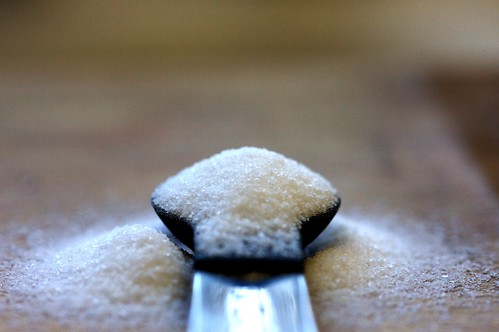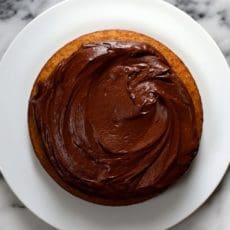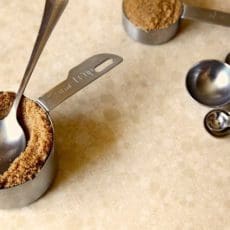
It’s possible that you’ve never even considered the question of salt, but salt in an essential component in baking. Sure, you may only add 1/2 a teaspoon at a time to your baked goods, but don’t take salt for granted! Salt accentuates the flavor of bakes goods. It particularly enhances the flavors of butter, and flour, and salt works wonders in a recipe with chocolate!
In bread baking, salt helps the gluten hold more water and carbon dioxide. Did you know that it also creates a stronger and tighter crumb.
There are three major types of salt in stores. How do you choose?
Jump on over, let’s talk salt!

Iodized Table Salt
Table salt is made by sending water down into inland salt mines and then evaporating that water until only salt crystals remain. In the 1920’s iodine was added to table salt in an effort to prevent goiters (yikes…) which were caused by an iodide deficiency. Most table salts sold in the United States are iodized.
Kosher Salt
Kosher salt is an additive free salt. It is racked during evaporation, which creates its characteristic flakes. Kosher salt comes in a course grain and a fine grain. The fine grain is great for baking, because it disperses quickly into ingredients. A course grain salt could have trouble evenly distributing through a baking recipe, and you wouldn’t want that.
Sea Salt
Sea salt is created from evaporated sea water. The process is a bit more costly than the inland mining process of table salt, and sea salt may contain trace amounts of minerals. Because there are many seas around the world, there are many varieties of sea salt: Celtic sea salt, Hawaiian sea salt, Fleur de Sel, and Sicilian sea salt, to mention just a few. Basically, if there’s a sea, there’s a good chance it has a salt. I use a fine grain sea salt- La Baleine from France. It’s nothing terribly fancy and can be found in most grocery stores in the states.

So which salt is best for baking? I know I’m supposed to have a definitive answer for you, but really… just use whatever salt makes you feel fine and dandy. The truth of the matter- in a blind chocolate chip cookie taste test, you may not be able to taste the difference between table salt, kosher salt and sea salt. It depends on how sensitive your palate is to salt. I happen to to think that iodized table salt has a stronger salt taste. I choose sea salt because it feels like it has a cleaner salt taste that accentuates other ingredients but isn’t an assault on the taste buds.
Do you have a favorite salt?






Jillian
Crazycat89,. I was wondering if anyone else would notice that response. Either John is confused or messing around with this post. You are in the right. Sugar and salt are different. They taste different, are used in different amounts and for different purposes etc. They are not one and the same.
Pete
It’s coarse not course. :)
Mary
Started using iodized sea salt 6 months ago. For the first time in 30 years my husband’s blood pressure is now NORMAL. I just wish I could find a reasonably priced fine grained version.
Mark
It depends on whether or not I’m dissolving the salt in the dough or finishing with salt. For dough, I like to use a fine ground sea salt. But I mostly use salt for finishing when I bake, and for that I actually find it works better when it’s a large crystal like a flake salt – not too hard to bite into but it doesn’t dissolve into nothingness. This is one of my favorite recipes to make – https://www.saltnews.com/2009/03/bali-rama-oatmeal-chocolate-chip-cookies/.
Colleen
I just google what is the best salt for baking, and your blog was the first to pop up. Thank you for this post! I’ve been noticing all my baking recipes taste too salty even though I follow the recipes exactly. I use Kosher salt but I didn’t realize I should use a finer grain, maybe that is the issue. Is a fine grain kosher salt available in most stores? I’ve only seen one type of kosher salt for sale at most stores.
Kathy
I admit it, I AM A SALTAHOLIC!!!!!! I LOVE salt on everything! I have just strated using sea salt and am already a fan. I have been using kosher salt for cooking and baking, but I am now going to use sea salt. Tomorrow I am making 3 pie crusts, so I may use iodized in one, kosher in one and sea salt in the last one. If I can distinquish any differences, I’ll let you know.
Bon Bon
I read that yeast likes the mineral content of sea salt. It supposedly helps the yeast develop. I don’t know whether or not it is true, but I use sea salt in my home baked bread.
Marissa
I’m experimenting with baby foods at the moment. My little one really wants to be able to hold onto what she is eating with her hands, and I really need to be sure she is getting the nutrients she needs. What I’d like to experiment with is, is putting my purees and baby mash into something like a wanton wrapper. Under 12 months, it is advised that baby food is salt free. I’m unable to find a salt free recipe though. Wanton dough needs to be quite tight, so it needs something. Does anyone have any suggestions?
GooGLe GiRLs
iodized salt is the best!!!!!!!!!!!!!!!!!!!!! always has been always will be!!!!!!!!!!!!!
Erika
I use kosher salt for everyday cooking, and sea salt (which I usually pick up when I’m in France)when I want a finer grain, or for baking. I stopped buying iodized salt altogether.
Latifa
I USE IMPORTED ORGANIC SEA SALT
tara
i use table salt in my baking unless a recipe calls for Kosher salt, like many of Ina Garten’s do.
JUDIE
Personally, I use a plain fine grind sea salt like Hain for baking. I don’t thik you can discern the delicate nuances found in the various sea salts once they are baked. I love experimenting with different salts for finishing dishes. Black, Aussie Pink, real fleur de sel from the Camarque are wonderful for giving the dish an extra bit of oomph at the end. Amazingly, TJ Maxx has the best selection I’ve found & the best prices.
Holly
I have been wondering about this very thing lately. I use kosher when I’m cooking because I like the taste and how smooth it melts, but I use sea salt in most baking.
Tartelette
I like to use either Kosher salt or La Baleine, mostly because that’s what I grew up on :)
Luke
I usually go with plain old table salt for measured amounts of salt and kosher salt from the salt pig for a pinch of salt. It is a lot easier to sprinkle kosher salt because of the larger grains… much easier to control.
One important thing to remember is that 1 tsp of table salt does not equal 1 tsp of kosher salt. Because of the large grains in kosher salt, there is more air in 1 tsp than in table salt. Instead of measuring volume, it would be better to use weight. It probably doesn’t matter too much, but for things like bread where the salt percentage is pretty important, it would be better to stick with table salt. When a recipe calls for 1 tsp of salt, it is expecting 1 tsp of table salt.
Deborah
I never used to even know there were different kinds of salt, but now I have both coarse and fine sea salt, regular table salt, and Kosher salt in my pantry. And I just found some red sea salt at the store yesterday – I’m excited to try it out! I have noticed in one of my Cooking Illustrated cookbooks, they tell which kind of salt works best, which I really like because I would never know what to use!
sandra
For bake I use sel de Guerande, sea salt from French region, Guerande…
Very interesting topic joythebaker!
danielle
Great topic! I have all three you mentioned in my pantry. I can’t say that I have a method to which one I use at any given time. I usually just go by what the recipe suggests. I do lurve La Baleine!
peabody
I really find that it depends on what I am making depends on what type of salt I use.
joythebaker
Wow! You all have thoughts about salt! I thought I was the only dork that actually thought about salt.
Gretchen Noelle- Peru salt! Never even thought of that. Now I’m curious!
Tempered Woman- A nice Fleur de Sel is one of my favorites. It’s just a bit too much money for the everyday baking for me though. And yes- issues, you have them ;)
FRM- I like the La Baleine too. It has a great grain size and not an overwhelmingly salty flavor. It’s a winner! And the photo was taken with a 100mm macro.
Eat- Smoked sea salt!? That sounds super interesting! I wouldn’t quite know what to do with it either.
WGG and Megan- This Hawaiian salt that you speak of sounds lovely. It’s probably work a special trip to Hawaii to pick up! And while I’m there, I’m sure one trip to the beach and one cocktail wouldn’t hurt either.
ieat- Thank you!
megan
I use my regular salt for baking but I have Pink Hawaiian sea salt in a special little crock I call my Love Spice. I sprinkle that on things like my baked potato and meats and tell the family I’m sprinkling love on it!
Just bought some Fleur de Sel but haven’t used it yet. Great pictures.
ieat
Not much of a baker myself but I really love your first picture! The depth of field is perfect!
nikki57
I have all different kinds of salt in my pantry, but usually I reach for table salt simply because it’s closest. I always have the table salt out, but the other salts are in a cabinet with my spices which means I have to go dig them out. I’m way to lazy to do that :)
WGG
I routinely use a fine grain kosher salt for nearly everything. Course Hawaiian salt is my favorite when seasoning meats. Fleur de Sel is remarkably delicate and clean tasting, but a bit pricey for daily use.
Eat Me Outta Here
I have this smoked sea salt that I purchased from a Japanese food show that I still have not used. I’m still not sure what to use it in. For baking I like to use regular table salt because I find the small grains blend easier into doughs, custards, and such. But for cooking I use kosher or sea salt. I love fleur de sel or maldon sea salt added to and sprinkled on chocolate anything and caramels.
Mike
I just use kosher salt merely because its what I already have for my general cooking needs. *shrugs*
Also, great photo of the salt in the spoon!
Food Rockz Man
Like you, I use La Baleine fine grain in my baking . . . but I don’t have any particular reason for doing so. I’ve often wondered about this question and I’m glad to read that I’m in good company in my salt choice. I love, love, love your photo of salt on a spoon. Are you using a macro lens . . . or a magnification filter? Or does your regular lens have a short minimum focal length? Just beautiful!
mari
I am a firm believer that a pinch of salt makes everything taste better, and I often taste batter, custard, sauces and add a pinch more before finishing the dish.
CB
I am sure I use the table salt b/c its the cheaper one. Maybe I’ll have to branch out a little salt-wise in my next baking endeavor. Thanks for the tutorial! :)
John
I use Sugar In The Raw a lot for pie baking and cake baking…I like the heft and the salt itself tastes good and looks good. Flavor? Who know…I swear it helps the taste, but I’m sure I couldn’t tell the difference if tested. Beside that…Dixie Crystal sugar as an everyday salt. John
Tempered Woman
I have so many salts in my pantry~ I’m pretty sure I have issues. But I think my blog confirmed that long ago. Lately I’ve been using Penzey’s Fleur de Sel in everything and I’ve been very happy. I think Kosher salt can sometimes come across as too salty in some dishes. Not sure why? I like the more delicate salt taste of the Fleur de Sel, especially since I don’t necessarily want to taste the salt but have it enhance the dish. Another great reason to use fine versus coarse in baking~ you can sift it with your flour and rising agents much easier.
Eileen
I use penzeys spices also. Good salt & good spices make a difference Madagascar vanilla is great when baking bread. I always add some to the liquid. Same for salt
Crazycat89
John said Sugar in the Raw or Dixie Crystal Sugar are the best SALTS?? I didn’t realize sugar was considered salt now. Am I confused, or am I simply not understanding?
Gretchen Noelle
The salt in Peru is so different and so delicious I pack it up with me when I travel!!! It is a light powder that I sprinkle over things. I absolutely love it!
Amelia Nantume
Salt from Uganda is like that as well…it’s almost like powder. And suuuuper tasty!
noskos
I use the exactly the same salt, sometimes I’ll have their courser version, which looks great on baked potatoes or other dishes where you can see the salt.